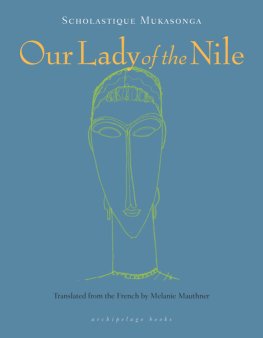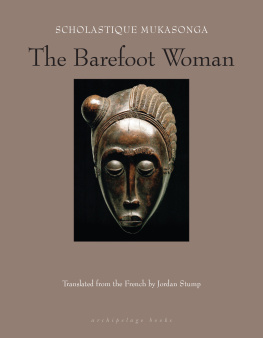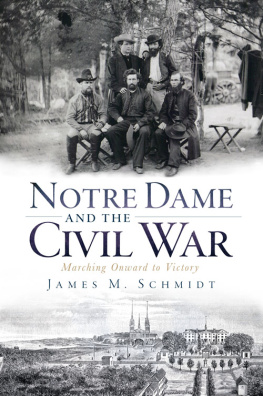Scholastique Mukasonga
Our Lady of the Nile
There is no better lyce than Our Lady of the Nile. Nor is there any higher. Twenty-five hundred meters, the white teachers proudly proclaim. Two thousand four hundred ninety-three meters, points out Sister Lydwine, our geography teacher. Were so close to heaven, whispers Mother Superior, clasping her hands together.
The school year coincides with the rainy season, so the lyce is often wrapped in clouds. Sometimes, not often, the sun peaks through and you can see as far as the big lake, that shiny blue puddle down in the valley.
Its a girls lyce. The boys stay down in the capital. The reason for building the lyce so high up was to protect the girls, by keeping them far away from the temptations and evils of the big city. Good marriages await these young lyce ladies, you see. And they must be virgins when they wed or at least not get pregnant beforehand. Staying a virgin is better, for marriage is a serious business. The lyces boarders are daughters of ministers, high-ranking army officers, businessmen, and rich merchants. Their daughters weddings are the stuff of politics, and the girls are proud of this they know what theyre worth. Gone are the days when beauty was all that mattered. Their families will receive far more than cattle or the traditional jugs of beer for their dowry, theyll get suitcases stuffed full of banknotes, or a healthy account with the Banque Belgolaise in Nairobi or Brussels. Thanks to their daughters, these families will grow wealthy, the power of their clans will be strengthened, and the influence of their lineage will spread far and wide. The young ladies of Our Lady of the Nile know just how much they are worth.
The lyce is very close to the Nile, to its source, in fact. To get there, you follow a rocky trail along the ridgeline. It leads to a flat parking area for the few tourist Land Rovers venturing that far. A sign reads: SOURCE OF THE NILE  200 M. A steep path brings you to a heap of rocks where the rivulet spurts between two stones. The water pools in a cement basin, then dribbles over in a thin cascade and along a little channel, before disappearing down the grassy hillside into the tree ferns of the valley. To the right, a pyramid has been erected, bearing the inscription: SOURCE OF THE NILE. COCK MISSION, 1924. Its not a very tall pyramid: the girls from the lyce can easily touch the broken tip they say it brings good luck. Yet its not the pyramid that draws them to the source. Theyre not here to explore; theyre on a pilgrimage. The statue of Our Lady of the Nile looms among the large rocks overhanging the spring. Its not quite a grotto, although a sheet-metal shelter protects her from the elements. OUR LADY OF THE NILE, 1953, reads the engraved pedestal. It was Monsignor the Vicar Apostolic who decided to erect the statue, in order to consecrate the Nile to the Virgin Mary, despite the King of Belgium persuading the Sovereign Pontiff to consecrate the whole country to Christ the King.
200 M. A steep path brings you to a heap of rocks where the rivulet spurts between two stones. The water pools in a cement basin, then dribbles over in a thin cascade and along a little channel, before disappearing down the grassy hillside into the tree ferns of the valley. To the right, a pyramid has been erected, bearing the inscription: SOURCE OF THE NILE. COCK MISSION, 1924. Its not a very tall pyramid: the girls from the lyce can easily touch the broken tip they say it brings good luck. Yet its not the pyramid that draws them to the source. Theyre not here to explore; theyre on a pilgrimage. The statue of Our Lady of the Nile looms among the large rocks overhanging the spring. Its not quite a grotto, although a sheet-metal shelter protects her from the elements. OUR LADY OF THE NILE, 1953, reads the engraved pedestal. It was Monsignor the Vicar Apostolic who decided to erect the statue, in order to consecrate the Nile to the Virgin Mary, despite the King of Belgium persuading the Sovereign Pontiff to consecrate the whole country to Christ the King.
Some people still remember the unveiling ceremony. Sister Kizito, the old, somewhat frail cook, was there that day. Every year she describes the occasion to the new pupils. Oh, it was a beautiful ceremony, similar to those you see in church, in Kigali, at Christmas, or in the stadium, on Rwandas National Day.
The Kings official representative sent an envoy, but the colonial administrator was there too, flanked by an escort of ten soldiers. One held a bugle, another carried the Belgian flag. Various chiefs and deputy chiefs were in attendance, along with those from neighboring chiefdoms. They brought their wives and daughters, who wore their hair piled high and pinned with pearls, they brought their dancers, who shook their manes like valiant lions, and of course they brought their herds of long-horned inyambo cattle decked with flower garlands. The hillside was thronged with farmers. Naturally, the whites from the capital didnt dare venture onto the rough path that led to the spring. But Monsieur de Fontenaille, the coffee planter who lived next door to the lyce, was there, sitting beside the administrator. It was the dry season. The sky was clear. No haze wreathed the mountain peaks.
We waited. Finally, a black line could be seen approaching on the ridge path, and a murmur of hymns and prayers arose. One by one they came into focus: Monsignor the Vicar Apostolic, with his miter and crosier, looking like one of the Three Wise Men from the pictures they show in catechism class. The missionaries walked behind him: they wore pith helmets, as all the whites did back then, but were bearded and dressed in long white robes with a chunky rosary around their necks. Children from the Legion of Mary strewed the path with yellow petals. Then came the Virgin. Four seminary boys in shorts and white shirts carried her on a plaited-bamboo litter, the kind used to take a young bride to her new family, or the dead to their final resting place. But it was impossible to see the Madonna because she was wrapped in a blue and white veil. Behind her jostled the native clergy, and then, preceded by their banner and the white and yellow papal flag, came the straggling line of catechism pupils, straying cheerfully off the path onto the slopes, despite the best efforts of the monitors with their sticks.
The procession reached the hollow and the spring; the Madonnas palanquin was lowered beside the stream she was still hidden beneath the veil. The administrator stepped forward and greeted Monsignor with a military salute, exchanging a few words while the rest of the procession took up position around the spring and the statue, which had been raised onto a little stage. The Bishop climbed the five steps with two missionaries, blessed the crowd, then turned to face the statue and recited an oration in Latin, with the two priests giving the response. Suddenly, with a nod and a wave from the Bishop, one of the acolytes unveiled the Madonna. The bugle sounded, the flag was dipped, and a hushed murmur spread through the crowd. The hollow filled with the womens sharp cries of joy and the jingling of the dancers ankle bells. The Virgin who appeared from beneath the veil certainly resembled Our Lady of Lourdes, who can be seen at the mission church dressed in the same blue veil, the same azure belt, the same yellow dress, but Our Lady of the Nile was black: her face was black, her hands were black, her feet were black. Our Lady of the Nile was a black woman, an African woman, a Rwandan woman and indeed, why not?
Its Isis, cried Monsieur de Fontenaille. She has returned!
And so, with a vigorous sprinkling of holy water, Monsignor the Vicar Apostolic blessed the statue, blessed the spring, and blessed the crowd. Then he delivered his sermon. Not all of what he said was comprehensible. He spoke of the Holy Virgin, and how she would be known here as Our Lady of the Nile. He said: The drops of this holy water shall mix with the burgeoning waters of the Nile, which in turn shall mix with other streams and become The River, flowing through lakes, flowing through swamps, pouring over waterfalls, braving the desert sands, soaking the cells of bygone monks, even lapping at the feet of the surprised Sphinx. It is as if, by the grace of Our Lady of the Nile, these holy drops were to baptize all of Africa; and Africa now Christian shall save this world from perdition. And I see, yes, I see, crowds thronging here from all the nations in pilgrimage, yes, in pilgrimage, to our mountains, to give grace to Our Lady of the Nile.
When his turn came, Chief Kayitare walked up to the stage and called to Rutamu, his cow, which he offered to the new Queen of Rwanda. He praised both the cow and the Virgin Mary, saying they would provide milk and honey in abundance. The womens cries of joy and the tinkle of the dancers bells approved this auspicious gift.







 200 M. A steep path brings you to a heap of rocks where the rivulet spurts between two stones. The water pools in a cement basin, then dribbles over in a thin cascade and along a little channel, before disappearing down the grassy hillside into the tree ferns of the valley. To the right, a pyramid has been erected, bearing the inscription: SOURCE OF THE NILE. COCK MISSION, 1924. Its not a very tall pyramid: the girls from the lyce can easily touch the broken tip they say it brings good luck. Yet its not the pyramid that draws them to the source. Theyre not here to explore; theyre on a pilgrimage. The statue of Our Lady of the Nile looms among the large rocks overhanging the spring. Its not quite a grotto, although a sheet-metal shelter protects her from the elements. OUR LADY OF THE NILE, 1953, reads the engraved pedestal. It was Monsignor the Vicar Apostolic who decided to erect the statue, in order to consecrate the Nile to the Virgin Mary, despite the King of Belgium persuading the Sovereign Pontiff to consecrate the whole country to Christ the King.
200 M. A steep path brings you to a heap of rocks where the rivulet spurts between two stones. The water pools in a cement basin, then dribbles over in a thin cascade and along a little channel, before disappearing down the grassy hillside into the tree ferns of the valley. To the right, a pyramid has been erected, bearing the inscription: SOURCE OF THE NILE. COCK MISSION, 1924. Its not a very tall pyramid: the girls from the lyce can easily touch the broken tip they say it brings good luck. Yet its not the pyramid that draws them to the source. Theyre not here to explore; theyre on a pilgrimage. The statue of Our Lady of the Nile looms among the large rocks overhanging the spring. Its not quite a grotto, although a sheet-metal shelter protects her from the elements. OUR LADY OF THE NILE, 1953, reads the engraved pedestal. It was Monsignor the Vicar Apostolic who decided to erect the statue, in order to consecrate the Nile to the Virgin Mary, despite the King of Belgium persuading the Sovereign Pontiff to consecrate the whole country to Christ the King.